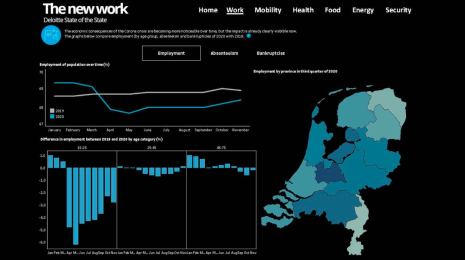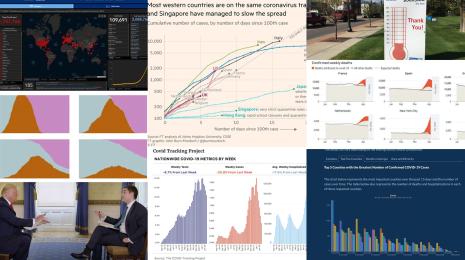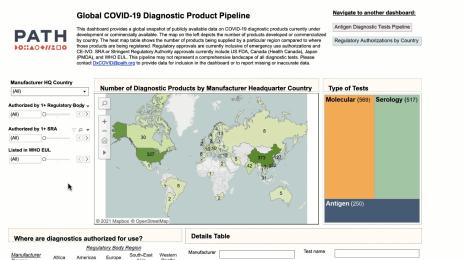Build a resilient future with these data-driven habits
Editor's note: This article originally appeared in Forbes.
Every agenda, from enterprise-wide goals to individual aspirations, has been rewritten by the pandemic. And like never before, businesses are searching for signals that will help them set new standards for commerce, socialization and safety.
It may seem incongruous at first, but the headwinds and uncertainty created by Covid-19 have created an ideal time for leaders to commit to data-driven strategies and innovation, according to Jackie Yeaney, executive vice president of marketing at Tableau.
“If there was ever a time for data leaders to shine, this is it,” she said.
Data democratization, the process of pushing insights and data throughout an organization and into the hands of front-line employees, is a worthy pursuit—but it’s not always enough. Equipping employees with reporting and analytics tools is just one step in a larger cultural transformation that ties data to an organization’s core mission.
Read on for advice on how to create a resilient foundation using analytics.
Responding to crisis requires in-the-moment insights

If the role of analytics in your organization has solely been to look in the rearview mirror and understand what’s already happened, now is the time to change, said Ashley Howard Neville, senior technical evangelist at Tableau.
In baseball, a team manager who changes game strategy based on up-to-the-minute numbers can impact the final score. A manager who waits for the final data to come in—after the team has already lost—has missed their chance to alter that outcome.
“Businesses today are saying that they are much more interested in how things are changing than where they ended up because they want to use data to change outcomes,” she said. Timely analysis can be the difference between winning and losing.
That’s why an organization-wide data culture is important—along with the right technology and an agile, data-literate workforce. When data is transformed from static reporting into a valuable tool, employees develop new habits, such as understanding trends and opportunities in the middle of tricky business cycles. A crisis can kick-start new habits around data and analytics, when uncertainty is high and agility is necessary.
“The leaders I’m talking to say that waiting too long to find the answers you are 100% confident in can be far worse than making a timely move with 80% confidence,” Yeaney said. “They’re stepping back from complex visualizations in favor of simple, agile tools that senior leaders can use.”
Before the pandemic, UNC Health, a public health system with 11 hospitals and hundreds of clinics in North Carolina, had developed a strategic plan for gradual data transformation. Covid-19 accelerated the rollout of new technology and new kinds of collaboration. In the beginning, the analytics team created dashboards for executive and leadership teams to monitor metrics like testing, utilization and personal protective equipment inventory. And after a few weeks of success, they scaled these efforts to over 30,000 internal users. The team continues to find new ways to look at their business to deliver better health outcomes.
Increase ownership with a data task force

Senior leadership can drive better results from data and analytics by creating a multidisciplinary task force to dig into challenges stemming from the pandemic.
When Covid-19 spread worldwide and businesses started to move to remote work, Tableau saw an opportunity to lead by example, creating its own task force to put reliable insights on the pandemic in a publicly accessible data hub.
“Everyone wants to invite people back to the place of business in ways that keep them safe,” said Jeremy Blaney, senior manager of customer success at Tableau.
The task force peaked at 40 members and represented a variety of business and technical backgrounds. Initially, Tableau focused on speed and relevancy, giving the team wide latitude to dispatch insights as fast as possible without worrying about aesthetics, said Yeaney.
But several months into the work, Tableau recognized an opportunity to enhance the user experience by focusing more on presentation and convenience. New members have joined the task force to inject fresh ideas and to give the founding members of the task force a well-needed break.
“We’ve reduced the size and created a smaller team with clearer roles,” Yeaney said. “And we’ve brought in people who haven’t been working on this for the past six months to bring in new energy.”
A centralized data task force, particularly in times of crisis, can bring focus, speed and agility to data processes. It can also spur innovation and become a model for other areas of the business to follow.
Investing in the future
A data culture can transform an organization’s decision-making—but cultivating one requires time, investment and company-wide commitment. Leaders ready to move ahead with data culture initiatives will benefit from these four strategies:
1. Get buy-in from senior leadership.
Change the perception of analytics as a technical, cost-center investment to a strategic priority with high-level sponsorship. “If you don’t build sponsorship on the business side, with leaders high enough in the business who understand how data can be used day to day to affect the business, you’re not going to be successful,” Howard Neville said.
2. Measure your progress accurately.
Howard Neville said that many organizations overestimate the depth of their commitment to analytics relative to their peers.
“It’s not that lower-performing organizations lack data programs—they may have two or three when they really need seven. And it’s not that they aren’t asking for data skills on job applications, but that the skills they ask for aren’t advanced enough,” she said. “As you start making these small improvements, you see business value.”
3. Give credit to analytics when credit is due.
The payoff for analytics in a time of rapid change is similar to that of brand positioning efforts. The right insights could guide a decision that saves millions of dollars or opens up a new market because a competitor couldn’t sustain service levels during the current crisis. Those insights need to be credited to analysis, not just intuition.
4. Promote analytics even when times are good.
Acknowledge that it doesn’t take a global crisis to justify a sense of urgency around data or to empower more leaders and employees to take action backed by analytical insights. “Moving fast applies in non-crisis situations as well,” Blaney said. “With the velocity of data being presented to any organization, you don’t have the luxury of moving slow.”
Want to know more about the value of data culture? Check out this data culture explainer on Tableau.com for unique perspectives, customer stories and helpful tips.
Related Stories
Subscribe to our blog
Get the latest Tableau updates in your inbox.







